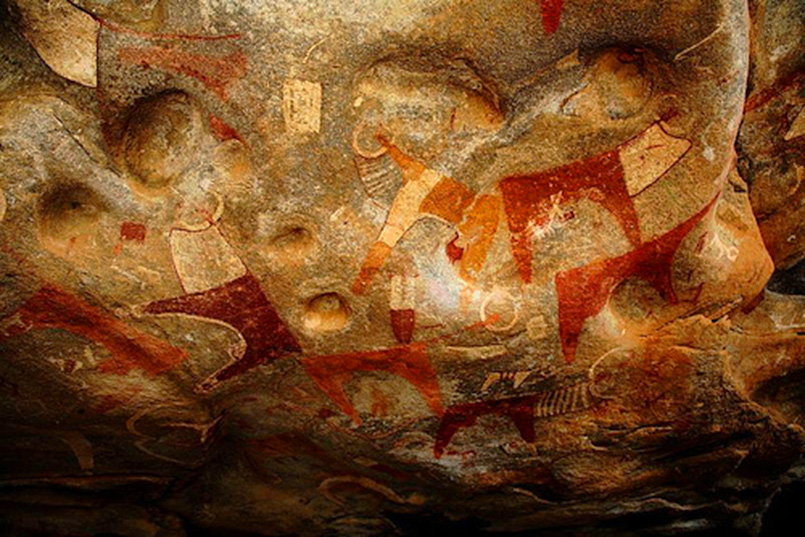
Humans have been painting to memorialize their lives since the Stone Age, using techniques that endure to this day.
The earliest art supplies we’ve found—abalone shells full of ground ochre and charcoal—were in the Blombos Cave in South Africa, and are up to 100,000 years old. But we haven’t yet found paintings to go with them.
By 40,000 years ago, tribes in Europe, Australia, and Indonesia painted images of hunters and herders on cave walls, and had expanded their palette to include many colors.
Pigments for these paints included blood, sap, berry juices, dried plants and roots, and many minerals.
Iron oxide pigments were highly valued for their durability, and prehistoric mining trails around the famous Lascaux Cave in France suggest that, 25,000 years ago, painters traveled many miles for these materials.
Early artists mixed their pigments into paint using water, saliva, urine, or animal fats. They then applied them with fingers, brushes, or by blowing them through hollow bones, like today’s airbrushes.
The Egyptians continued the modern advancements, mixing paints with binding agents like egg and began painting on plaster.
Greeks and Romans expanded upon these techniques, to create a painting style not matched till the Renaissance—when Italian artists made paint with plant oils to create works of astonishing color and depth that still captivate viewers today.
Background
Synopsis: Humans have expressed themselves for more than 40,000 years using mineral-based pigments. How did ancient people find and use pigments? How did the use of pigments evolve through time into the creation of the paints we know today?
- Primitive artists used natural materials available to them to mark their territory, beautify their surroundings, and tell their stories. For thousands of years, paints were handmade from ground-up mineral-based pigments.
- During this time, pigments—dry, insoluble coloring material that produces paint when mixed with a type of base—included charcoal; blood; sap; berry juice; and ochre, a pigment colored red, yellow, or brown by iron oxides (rust) and iron hydroxides. These were mixed with bases of water, saliva, urine, or animal fats to create paint.
- The oldest archaeological evidence of paint making was found in the Blombos Cave in South Africa. An ochre-based mixture was dated at 100,000 years old, and a stone toolkit used to grind ochre into paint was found to be 70,000 years old.
- Paleolithic cave paintings dated at up to 40,000 years old in Europe, Australia, and Indonesia depict humans and animals painted with ochres, calcite, charcoal, hematite, and manganese oxide.
- Primitive painters applied paint by brushing; smearing; dabbing; and blowing it through hollow bones, like an airbrush.
- Because pigments come from minerals, trace minerals that remain in the ground pigment can still be viewed with a microscope, providing clues about where it was originally mined and how it made its way along trade routes to the artist—including the 25 mile trek of cave painters from the source of their ochres to the Lascaux Cave 25,000 years ago in what is now France.
- The adoption and evolution of artistic practices in various locations illustrates collaboration among artists across the ancient world, from the Egyptians and Minoans to the Greeks and Romans.
- Egyptian tombs made of limestone were covered in plaster and painted using six colors: charcoal black, red ochre, yellow orpiment, brown ochre, blue azurite, and green malachite. King Tut was buried with a paint box that contained powdered malachite, orpiment, and red ochre.
- Egyptian artists added pigments to binders like egg, resin, or beeswax so the paint would adhere to the plaster.
- The Minoans developed the technique for frescoes by painting onto wet lime plaster, increasing the durability of the artwork.
- Greeks developed lead white paint, which was the most popular white paint in use until titanium dioxide replaced it in the nineteenth century. Lead-based paint has been the source of health issues for painters and others for centuries.
- Greeks used beeswax-based encaustic painting techniques for pictures and murals that have lasted for centuries.
- Romans used Egyptian and Greek pigments and added red vermillion mined in Spain.
- After being covered by ash flows from erupting Mount Vesuvius in 79 BC, several Roman towns such as Pompeii were forgotten until an accidental discovery in the eighteenth century revealed a snapshot into Roman life and its well-preserved art.
- The towns’ beeswax-based encaustic murals and large frescoes, which borrowed techniques from the Greeks and Minoans, have endured vividly to the present.
- Dyes made from plants were also used in artwork in the Mediterranean region. Madder made red dyes; saffron, turmeric, and pomegranate rind made yellow; and indigo made dark blue. Other colors could be mixed from these primary hues.
- Middle Ages, Renaissance, and Modern painting introduced new materials, colors, and technologies.
- In the Middle Ages, a common method of painting used egg tempera, in which pigment is mixed with water and egg. To avoid cracking, the technique required glazing—transparent layers added on top of a painting—which created a highly finished appearance.
- Ultramarine was a new color in the Middle Ages, derived from lapis lazuli mined in Afghanistan.
- In the Renaissance, walnut or linseed oil replaced egg as the base for pigments used on canvas; the richness and depth of color this technique made possible enabled painters to create new luminous effects in their art.
- Natural mineral pigments were dug from the earth and shaped into sticks that were used as chalks by artists including da Vinci, Michelangelo, and Rembrandt.
- Pre-mixed paint cakes for artists were first manufactured and sold in the eighteenth century.
- Sherwin-Williams sold the first pre-mixed wall paints in 1867. Before that, people had to mix their own wall paint from powdered pigment. By the mid-nineteenth-century, watercolors were also available for sale to the public.
- Since the 1940s, technological advances have produced synthetic pigments and chemical processes for paint making—leading to easier preparation for artists and house painters alike and vastly expanding the once mineral-based limited color palette to all the colors of the rainbow.

